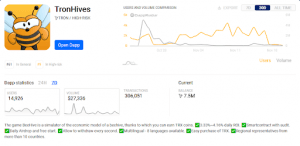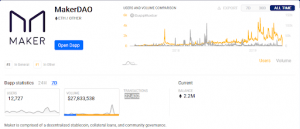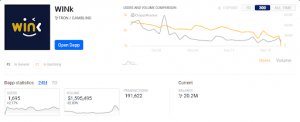Reading the data: DAUs Vs Transaction Volume
The Industry Talk section features insights by crypto industry players and is not a part of the editorial content of Cryptonews.com.
This article has been brought to you by DappRadar, a dapp data aggregator and analysis firm.
_____

There are over 4,500 cryptocurrencies listed at coin tracking site, CoinMarketCap. The vast majority of these projects are open-source, meaning that lots more will be coming in the future. Presently, it is somehow of a conflated playfield. The more innovators pour in, the more developers question their tech-savviness.
Almost all the projects are ambitious, but only a few become wildly successful. Others have registered moderate success despite the incredible features they claim to add to this industry. It is what blockchain presents; it is an opportunity for all and sundry.
Statistics have it that by 2024, leading corporations will spend over $20 billion per year on blockchain technical service. Given the size of this pie, the race is on among blockchain projects. Last year, 90% of European and North American banks were exploring how to integrate blockchain in their operations.
Over to dapps
However, it is the development in the decentralized applications (dapps) sector that is picking interest. The emerging world of dapps raised eyebrows following the explosive popularity of Cryptokitties in early 2018, the year of dapps. This period pushed Ethereum to the edge, sparking changes that are currently being implemented. It’s the hype around dapps that sparked its rise despite the harsh market condition of 2018.
At the moment, we can authoritatively say that there are 10 active smart contracting platforms that supplement Ethereum. The latter is the pioneer and undoubtedly the most decentralized, secure but with low throughout. A characteristic that is surprisingly not fazing developers. With smart contracts come dapps, and that is where it gets interesting.
For the uninitiated, a dapp is a decentralized application that can operate from a public blockchain, meaning it is censorship-resistant, highly reliable, and its main component is an (audited) smart contract. To further elaborate, a dapp can be anything; a website or even a mobile application. It doesn’t really matter because as long as the code that underpins the product runs on the blockchain, then it is still a dapp.
Currently, there is an “outbreak” of dapps. There are tons, ranging from those offering solutions in token exchange, gambling, gaming, and so much more. The list is endless. They may be millions with those in gambling and gaming dominating the chart, but what analysts are looking at is numbers. Statistics that indicate whether the blockchain field, regardless of how nascent, is headed in the right direction.
Daily Active Users (DAUs) versus Transaction Volumes
Only numbers matter, and since they don’t lie, it is essential to compare and contrast how valuable nuggets can emerge from the below measures.
To confidently project how the dapp market will fare as blockchain gains traction, we should fix our eyes on dapps:
Daily Active Users (DAUs)
The DAU is a metric that shows the number of unique public addresses that transact with the dapp’s smart contract. Most dapps rankings are based on their DAUs. The DAU is, therefore, a crucial metric in determining the performance of any dapp. A recent assessment of the Loom smart contracting network showed that although it was recently launched, the number of unique addresses interacting with the Base Chain is on an upward trend. The number of dapps being accumulated also increased with raw data indicating that the number of dapps peaked in September when three were added.
Overly, reliable statistics from DappRadar, a dapp tracking and ranking website, reveals that from the 10 smart contracting platforms tracked, the most active dapps are from Tron. In the last week, six of the top 10 dapps were from Tron, one from EOS and three from Ethereum. The leading dapp, when ranked by DAUs, was Tron Hives.

This dapp is a game which simulates the economic model of a beehive. In the last week, it has over 14,900 users generating $27,326 and retaining a balance of 7.5 TRXs in their wallet. Tron Hives is classified as a high risk dapp and its popularity has been dwindling. The number of active users peaked on Nov 9 when 4,400 users were actively playing. Since then the number has dropped to 203, a more than 98% fall, as recorded on Nov 20.
With the rise of Decentralized Finance (DeFi) as an alternative to banks, MakerDAO rise as one of the leading Ethereum based dapp marked by high DAU is no surprise. The number of active users is steady, and a rise reveals that demand is high. Although usage fluctuates, dropping 40% in the last week, users generated $27,833,538 in volumes from 22,432 transactions. In total, there are 2.2 million ETHs locked in eight smart contracts by MakerDAO. An all-time high of 5,540 users occurred on Aug 6.

Overly, in an industry report analysis of dapp performance in Q1 2019, it was found that Tron’s dapps cumulatively had 300,000 active users. The proliferation of gaming and gambling applications drew most of them. A glance at Tron’s top 10 performing dapp reveals that gambling and gaming-focused projects were dominant. WINk, a gambling project, had 21.7 million TRXs in their smart contract. Ethereum exhibits more diversity with exchanges, DeFi, and games more common.

Nonetheless, and this can’t be overlooked, the number of daily active users visiting the top 10 dapps in all the 10 tracked protocols is less than 10,000. For comparison and context, this is extremely low, and not in the same competition frame as Facebook or Twitter with millions of DAUs. Going by this dismal “audience”, it is clear that dapps are unfortunately far from mainstream adoption.
There are games, yes, and gambling applications-in their hundreds, true, but their successes are directly determined by how the underlying blockchain performs. Take DeFi dapps for example, some are providing solutions to real-world problems but are slowed down by Ethereum’s low throughput and scalability. No sooner do they attract users, than transaction fees rise discouraging use. Coupled with complex user interfaces by some dapps, general lack of technical know-how, high latency in decentralized exchanges and low sequential performance, it could take several years before network effect kicks in and the world shifts using dapps.
Transaction Volume
This metric is an alternative way of gauging the performance and the general health of the dapp ecosystem. Although it is hard to standardize this metric because a large percentage of dapps are inactive, generating low interactions, transaction volume is a reliable measure for measuring popularity. That’s not forgetting that it is prone to manipulation.
If we rank dapps depending on transaction volumes, then tables will turn. While Tron-based dapps have the highest number of users, few could make it to the top 10. Wink popped up but is the fifth most active dapp by transaction volume behind MakerDAO and two exchanges, Newdex operating from the EOS blockchain, and Oasis Trade, a new Ethereum based cryptocurrency exchange. Newdex’s transaction volumes were $5,089,979 from 16,638 unique transactions.

Compared, Kyber Network, an Ethereum based DEX, registered $891,870 in volumes from 1,108 transactions.

The only shining light despite transaction volumes dropping by 40% to $2.03 billion in Q3 2019 is the rise of DeFi products ran mainly from Ethereum, revealing how dapps, though in the early stage of use, will play a vital role in the push towards mainstream adoption. In 2019, $545 million went into DeFi, and 88% of these funds passed through Ethereum, explaining why Ethereum dapps are popular and rank higher in transaction volumes.
With DeFi, the important role played by Ethereum was further highlighted when it was revealed that billions of transaction volumes had not been captured as previous data suggested. Because of this, DappRadar will be ranking Ethereum dapps based on the total volumes of ERC-20 tokens that interact with its smart contract in the days ahead. This will improve transparency, painting an improved picture of the true state of the market.
To Cap it up
These two parameters act as pointers showing how well a dapp is faring. Notably, analysts have other ways of gauging performance, but these two are mostly prominent. However, both are susceptible to manipulation. Tactics as wash trading, especially in on-chain exchanges, represent a problem. At the same time, incentives as dividend tokens in gambling dapps mean it is hard to gauge actual volumes. Casinos, despite getting a bad rap for outright wash trading, pay part of their volumes to users. Plus, gamblers are always motivated to bet big on options bearing low risks.
A hybrid approach could deduce how a dapp performs. One can use external data from Alexa Rankings-a relatively neutral source and check social analytics on top of on-chain analytics as activity and volumes. To check how useful this is, one can check the number of visitors of any dapp from Alexa, and correlate its transaction volumes, or DAU, filtering out noise. DAUs and Alexa Ranking from where we can get the number of daily visitors should positively correlate.
Dapps are roughly two years old. They are relatively new concepts, and that is why even if they are struggling with volumes and activity, we expect developers to fine-tune them, improve UI, and ease of use overcoming business and adoption troubles with time.



